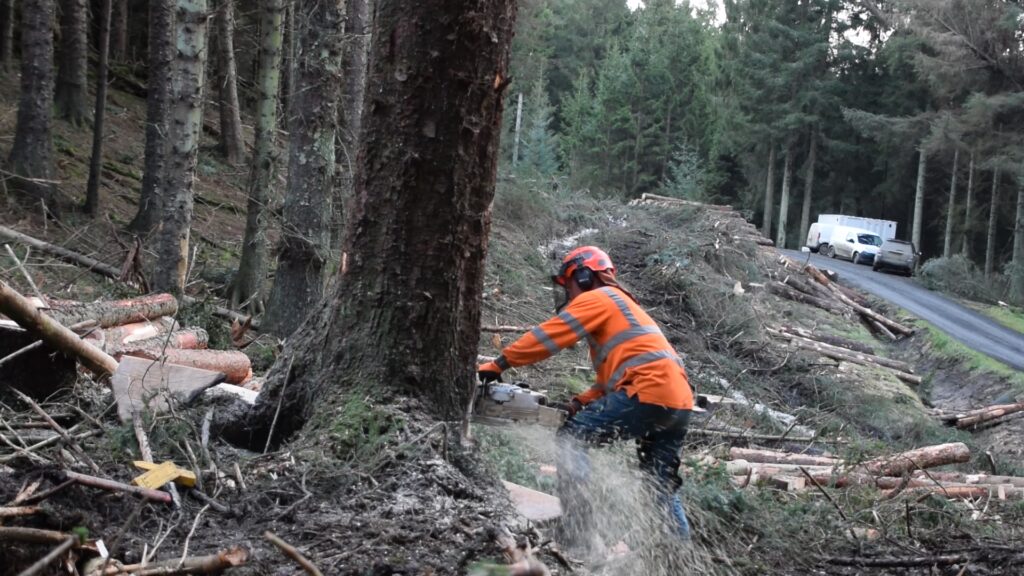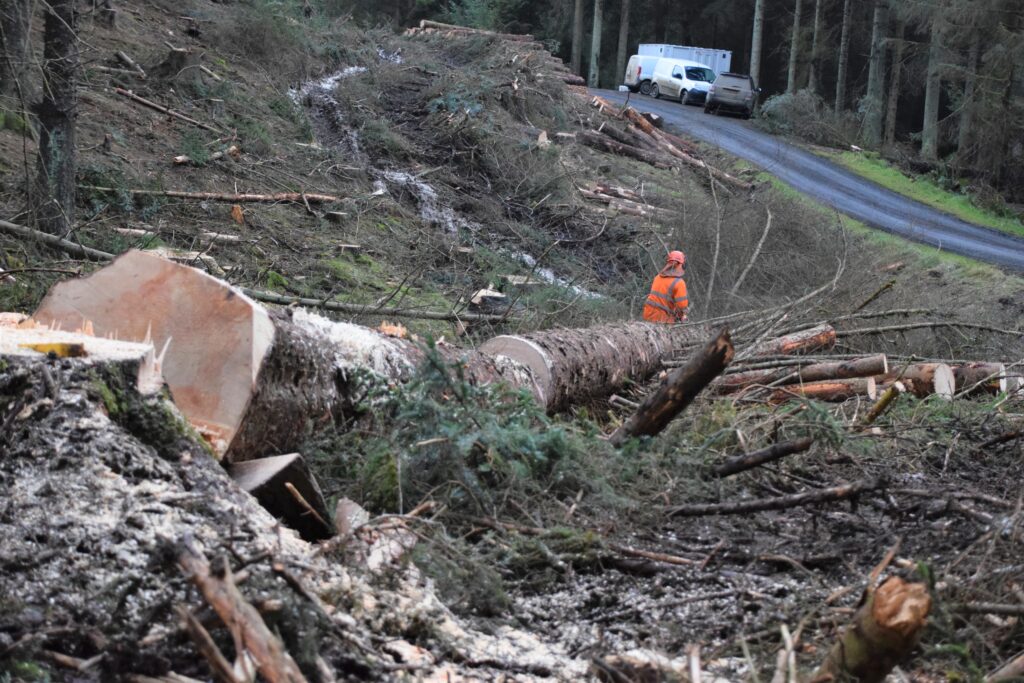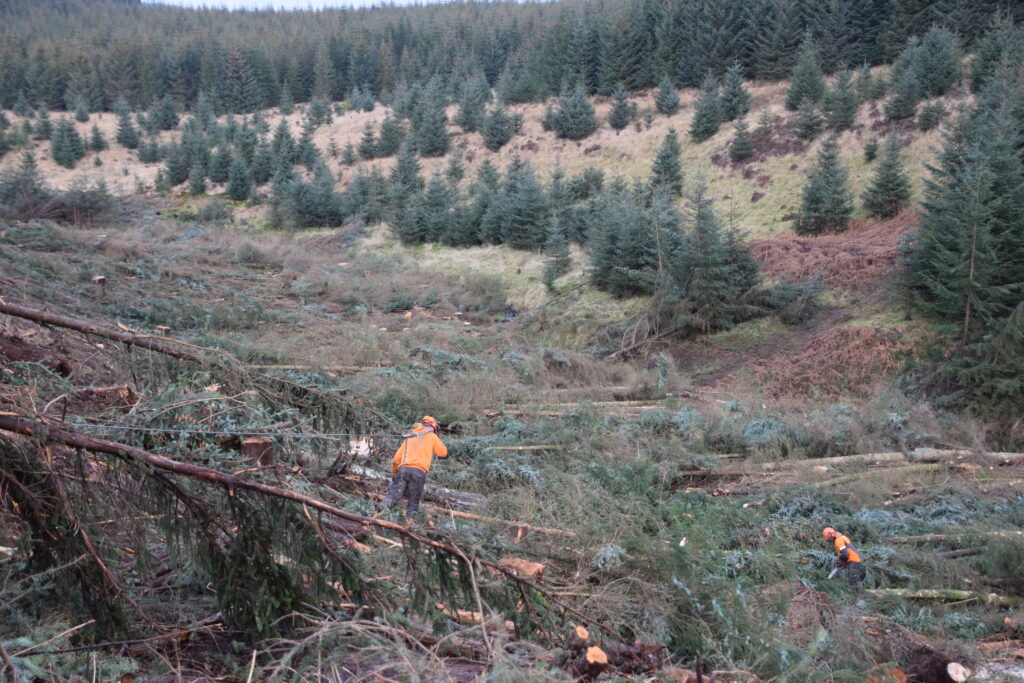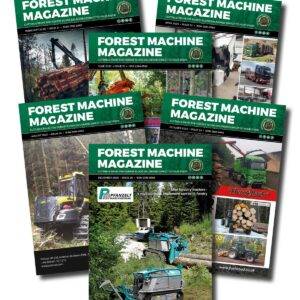Forest Machine Magazine visits Kielder forest to catch up with Stu Liddle of Liddle Forestry who has a team of chainsaw operators working in the North East and Scottish Borders.
I have seen and heard of many chainsaw operators being injured over the last few years and this is something I find concerning. Coming from an era (the 1970’s) where training and safety were non-existent, you basically bought a saw and headed to the forest in search of employment. It was mainly first and second thinning that was being done and the trees were felled manually, extracted by a skidder, cross-cut and stacked at the roadside.
It is hard to believe the equipment that was used then; chainsaws didn’t need anti-vibration mounts, safety chain brakes or chain catchers. Helmets with ear muffs and visor, safety boots and chainsaw protective trousers were rarely seen. Many of the skidders used were Fordson Major’s with a three-point linkage winch. There was no cab or roll over protection, no guarding and PTO guards were rare. What I find strange is that timber harvesting back then was labour intensive with probably thousands of untrained, unprotected chainsaw wielding maniacs attacking trees in forests all over the UK but, for some reason and to my knowledge, the accident rate remained relatively low.
I was one of the luckier ones as I worked for the Forestry Commission (FC). We had been on training courses and the equipment we were using was fit for purpose and regularly serviced. We had an effective two-way radio system for contact with our district office for when outside help was needed. Many of my fellow machine operator colleagues were of a similar age when they started out on the chainsaw, and all of them surprisingly still have their own limbs.
Accidents were rare in our forest district (for both FC and private contractors), even though everyone was on piecework. Cutting corners was normal practice to try and catch that carrot dangling on a piece of string in front of you. The majority of injuries incurred came from the annual battle at the Christmas Party where FC employees and private forestry contractors got together for a supposed social evening.
Working with a chainsaw in the forest is so different now, as you have to complete training courses and be certified by an assessor. Safety clothing is mandatory and the chainsaws have more sophisticated and efficient safety features with better felling aids available and all operators are trained in first aid. This all sounds great, but I have been out on-site with certified trained operators who haven’t a scooby what they are doing. One was felling large trees next to a public road and I had to abandon my feature and come away. Despite having all the relevant certificates and insurance I felt he was a danger to himself and others.
I have witnessed a few accidents recently when out on visits and I just don’t yet why this is happening. We are supposedly a million miles ahead in safety and training from where I started out, so where have we gone wrong in the industry? I have to admit to getting angry with all the effort that is getting channeled towards “Welfare Units” when it seems to me there are far more important issues that need to be addressed first.
Liddle Forestry
“I am a professional chainsaw operator and have been working in the forestry industry for twenty years”. said Stu. “Liddle Forestry recruit people with varying skill level from operators who have recently completed or are still currently at college, to operators who have worked their entire careers in the woods. Experience is key for successful chainsaw operators and the qualifications required to become an operative do not provide this. I believe that in order to produce competent operators and develop and strengthen the industry, that there needs to be a different approach towards training new, inexperienced operators.”
“We take newly qualified chainsaw operators on a regular basis and I would never send them away to fell these types of complicated trees just because they have the certificate to say they can. I make sure they are closely monitored and begin with easier work and build up to harder operations. We hold a regen contract and this is ideal for them to learn saw control, bring their confidence up and slowly introduce more complicated work when we believe they are capable. I am a believer that a newly qualified operator should be at stump with a highly experienced operator and watching them repeatedly carrying out felling operations. This would allow them to be shown the numerous types of hazards and complications along with many other things that need to be watched out for and reminded what needs to be taken into consideration. This doesn’t just involve the felling of the tree but things such as how it will fall and how it could roll and settle on the ground. I find it challenging to train new people to master the felling of oversized and dangerous trees to Liddle Forestry’s standard because they can’t be at stump with myself or another highly experienced member of my team. I’m not sure what the answer is but maybe a competence course could be introduced for experienced operators to allow them to have a newly qualified person with them at stump to be able to learn and constantly highlighting the technicalities involved and gain vital experience.”
“I believe that as Liddle Forestry has a big team of operators there is always at least one experienced guy there who is competent to fell complicated trees so a learner is not out of his depth which could cause accidents or injuries.”
Northumberland
I arranged to meet Stu at his workshop, I had never met Stu before, but we’d had contact via social media and I’d heard good reports from clients he has completed work for. Looking around his workshop brought back a lot of memories (I am still unsure as to whether they are good or bad). There was Tirfor winches and other felling equipment and aids I hadn’t seen and used for a very long time and he was fully equipped to deal with any manual tree operation. He was very well stocked with GB Lubricants chainsaw oils and it was there that I discovered he had up to 11 chainsaw operators working on 20 different harvesting sites and I started to appreciate the need for such a large stock.
It was good to get the opportunity to chat to Stu to find out a bit more about Liddle Forestry and how he got started in forestry. Stu went to Kirkley Hall College in Northumberland after leaving school but it concentrated more on the Arboriculture side of tree work. Stu’s father had his own contracting company so he joined him before branching out (no pun intended) on his own six months later.
Stu covers the North East of England and the Scottish borders with nine full time employees (other self-employed workers are drafted in when needed) and is kept busy as his services are in high demand. He has built up an excellent reputation and is highly thought of by the people, contractors and companies for whom he has carried out work.
Much of his work involves felling large and awkward trees that mechanical harvesters are unable to process with the Forestry Commission, TPH Ltd and Even Forestry Ltd amongst his long list of clients. He also carries out power line clearances, tree surgery with experienced climbers, dangerous tree removal, re-gen clearance and goal post-installation/maintenance/removal. He is well-equipped with two Valtra tractors; one with a forwarder trailer and Botex 570 crane and the other with either a Uniforest 8.5 tonne pulling power single drum three-point linkage winch or an Oehler 9.5 tonne pulling power remote controlled single drum three-point linkage winch. He has a lot of pulleys and accessories for the winches and is often called upon for de-bogging other machines.
Stu is able to chip on-site with his Jensen chipper thanks to variable width tracks which, when retracted, give a width of 1.2m allowing access to most gardens through a standard gate. It is capable of chipping up to 190mm diameter with its 37hp engine and can produce 15m³ of chip per hour.
Stu took us on a FC job he was working near Falstone Rigg, it was some of the nicest Sitka Spruce I had seen in a long time and this site was going to keep him busy, as many of the trees were too big for the Ponsse Scorpion with a H7 harvesting head. There was some windblow on this job with which he would have to deal with, while the edge trees were heavily branched and would need brashing in front of the harvester. He would need his tractor and winch as there was about 1000m³ of Larch trees to be felled and winched to an area where they were accessible for the harvester. Moreover, there were some trees close to a power line to be dealt with. This work was part of the five-year FC contract that had just been renewed. This was the fourth time that he had been awarded the contract and he has been working with the FC for the last 15 years.
Training
On the FC site we met and had the opportunity to chat to Liam McDonald, who was felling the big spruce trees. Liam is one of Stu’s younger operators and had started his forestry training on a two-year course at Newton Rigg College in Penrith, Cumbria. Liam’s main lecturer/instructor was Martyn Davies (now at Barony College, Parkgate near Dumfries) and Liam felt the course was brilliant. Part of the course included chainsaw felling of small diameter trees, cross cutting with a chainsaw and chainsaw maintenance.“Martyn was an excellent instructor who had a real passion for what he was teaching; he made the course interesting and enjoyable.” After leaving college Liam started working for Liddle Forestry where, to begin with, he worked on scrub control. This is when working for companies such as Liddle Forestry really benefits young operators like Liam as they have an excellent approach to further staff training. Although certificated, staff are supervised at all times to begin with and put on duties which will gradually increase their skill levels. Stu invests a lot of time and money in showing the trainees how the job is done safely and properly while continually
assessing their skill levels. By doing so, he makes sure they are confident and competent of the tasks which they are about to carry out.
READ MORE: Newton Rigg Ltd Launch Urgent Action Plan
Stu has his own strict health and safety policy which goes way beyond the legal requirements. His workers safety is paramount so in addition to training he carries out regular equipment checks and maintenance to make sure it is all safe to use and in good working order. His methods certainly work as he has had no incidents in the 20 years that Liddle Forestry has been in existence.
It was our chance to see Stu in action as he felled, de-limbed and cross cut 6.2m logs off a big Sitka until it was of a size the harvester could manage. The tree was probably between 3 and 4m³ in volume and after cutting, it didn’t take much with the hammer and wedge to persuade it to fall in the intended direction. It was a pleasure to watch Stu working as he was a thorough professional. It was no surprise to learn that he had been awarded the FC contract again and is in such demand when you see the quality of the work that he carries out. He was felling this tree with a Stihl, but his chainsaws of choice are Husqvarna and he has been using them continually for the last 20 years. He is often approached by Husqvarna to trial products and upgrades.
READ MORE: Husqvarna X-Cut C85 Professional Chain
Skidding
Stu had another site to show us where the work being carried out was a bit different. It was only about a fifteen minute drive away and was another FC clearfell site which had been almost completed. At the back of the harvesting site was a large gulley which was too steep and soft for the harvester and forwarder to work. Stu had his Valtra tractor with Oehler 9.5 tonne winch on site. A team of three of Stu’s men were felling and skidding the trees to the top of the gulley where the harvester was able to process them. It was bloody hard work and I was pleased I wasn’t the choker man. The team still managed to get about 50m³ of trees out of the gulley each day (they were chuffed that they had achieved 100m³ one day when skidding some decent-sized trees). There were some nice trees but a lot of small whips as well. There was a stream running along the bottom of the gulley which was prone to flooding so it was important that all of the trees and debris were removed.
You can tell when a team works really well together and this was the perfect example. When you hear the good-natured banter and ribbing that was going on between them, it’s a sure sign of people happy in each other’s company and happy workers are far more productive. I think one of the signs of an effective team is when watching them working you are
hard-pressed to pick out who is actually in charge. Something else I noticed was that although Stu pays the wages and is the employer, when on site he was just another team member. I take my hat off to Stu, his training methods and safety policies are definitely the way forward for the industry. When I worked for the FC at the start of my career, they were implementing a similar approach. The main difference was the FC had the backing and financial resources of the government behind them. Stu is managing to do this off his own back while still being competitive with his price tendering.










-
That’s a remarkable amount of work hours for a single machine, the Norcar 600 owned by Erkki Rinne is taken well care of, it even has the original Diesel engine.
-
Kieran Anders is a forestry contractor working in the lake district. His work involves hand cutting and extracting timber using a skidder and tractor-trailer forwarder.
-
It is not possible to eliminate chain shot, but there are simple steps that can be taken to reduce the risk.
-
Arwel takes great pride in the fact that the mill has no waste whatsoever, “the peelings are used for children’s playgrounds, gardens and for farm animals in barns in the winter and the sawdust has multiple uses in gardens and farms as well.
-
Timber hauliers need to encourage young blood in, and also look after the hauliers we have, we need make the sector a safe and positive place to work.
Find Us On
Forest Machine Magazine is written and edited by a forest professional with over 40 years hands on experience. We are dedicated to keeping you informed with all the latest news, views and reviews from our industry.
To support us you can subscribe to our bi-monthly magazine which is delivered to your door from only £30 per year.
Subscribe here
#homeoflogging #writtenbyloggersforloggers #loggingallovertheworld
-

 1 Year Subscription£0.00
1 Year Subscription£0.00

